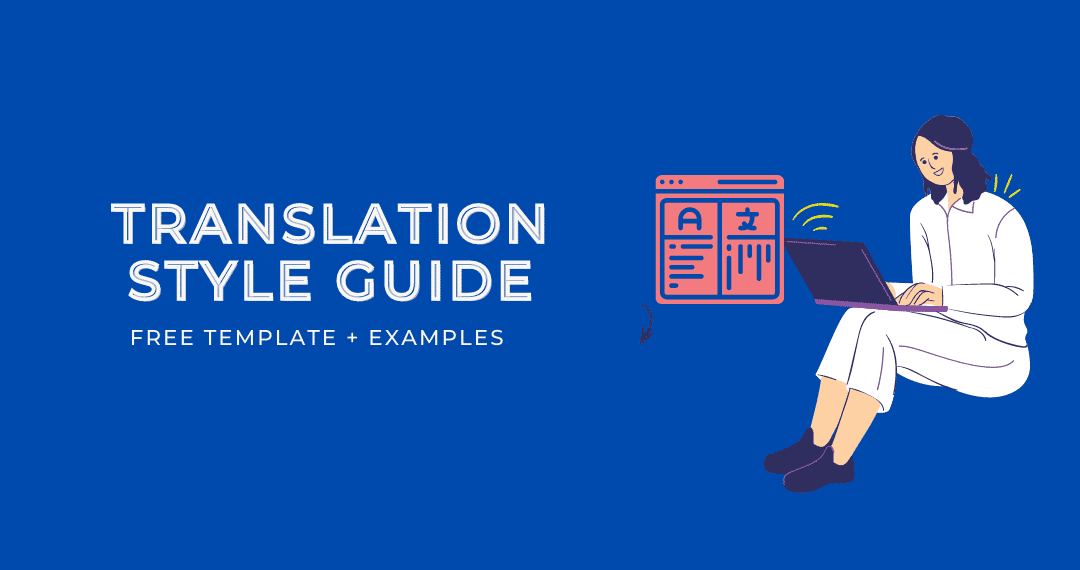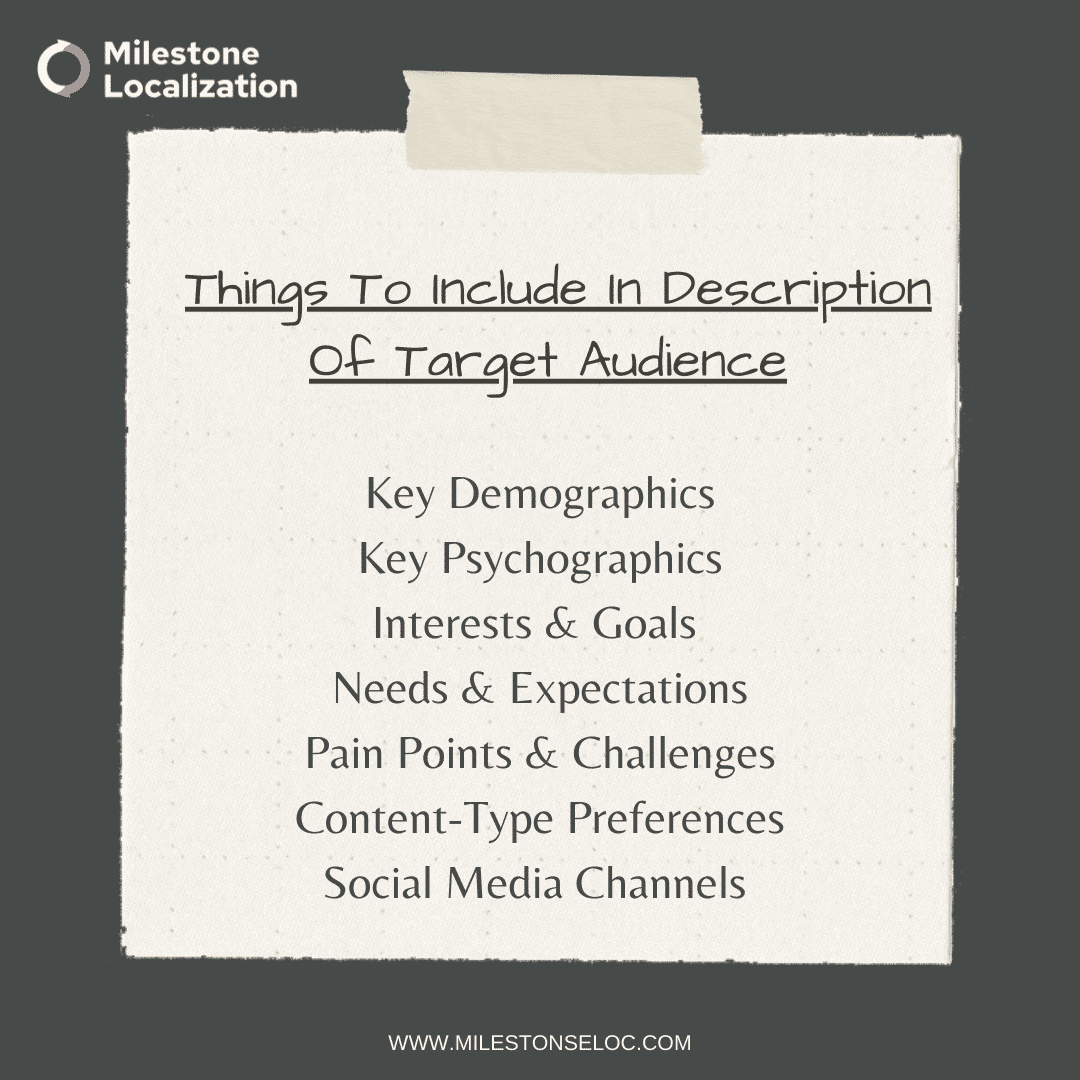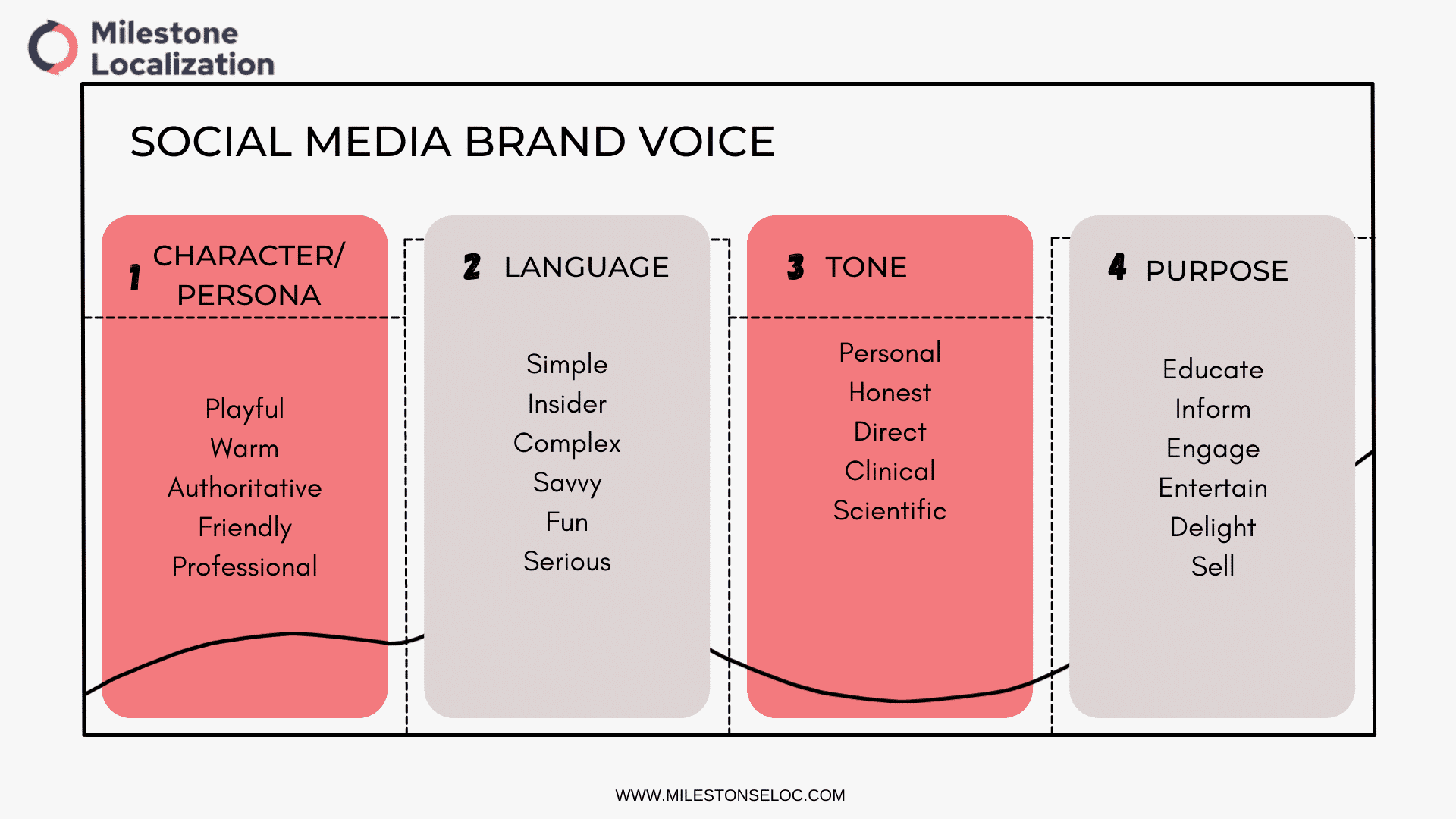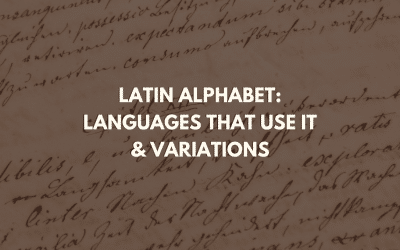Free Translation Style Guide Template
own style guide for an effective localization process.
Translation projects consist of complex processes, executed by several different people (such as linguists, project managers, localization engineers, QA specialists, etc.). Usually, these people are in places around the world, in different time zones, making communication and coordination a whole lot harder.
Translation companies use different software, tools, and processes to overcome these challenges and make the workflow efficient.
A translation style guide is one of the most useful and important tools in the localization process.
It is a way of setting expectations and aligning the client, LSP, and linguists while maintaining consistency and quality across the content.
The client reaps many benefits such as increased customer engagement, reduced costs, and a more effective localization process by creating a translation style guide for each language they translate into.
So what is a translation style guide?
Keep reading, and you will learn everything about why your company needs a translation style guide for your next localization project + find out the free template.
What Is A Translation Style Guide?
A Translation Style Guide is a guidebook that contains explicit rules on how a company wants to present itself in the market. This type of style guide, as its name suggests, is used to determine the style, both visual and textual, of a brand.
(A Style Guide Milestone Localization created for a client.)
In other words,
A translation style guide contains a detailed description of your company’s target audience, writing style, voice, tone, sentence structure, spelling, and frequent words/ terms that you want to be associated with your company.
It also gives detailed instructions on handling numbers, currencies, names, salutations, gender, links, and formatting.
The aim is to help translators and content creators understand your audience, goals, and brand voice.
The length of your style guide will depend on how big your company is and the scope of the localization projects. For larger projects, translation style guides can go up to 20 pages or more. For smaller ones – a few pages can be enough.
Also Read: What are Neologisms & How to Translate Them?
How to Create a Translation Style Guide?
Keeping in mind all these benefits, you can see that a translation style guide is an investment with high returns.
You shouldn’t be intimidated by the process of creating a style guide. Depending on the size of your company and the range of your products, it can take just a few hours to gather all the necessary materials.
Then you have to send them to your LSP (Language Service Provider), and they will do their magic. At Milestone Localization, the project manager works with clients to analyze the project and gather all the data needed to author the style guide.
It is best to assign the creation and reviewing of the translation style guide to someone in your company who is familiar with the marketing strategy, brand identity, and industry terminology of your company.
After the LSP prepares the style guide, the client must review it and add their comments and suggestions. Usually, 2-3 rounds of changes need to be made to arrive at the final document.
Remember! A Style Guide is a living document. As the scope of your project grows, the guide needs to be updated with new information
In this section, we will give you some tips and tricks on how to devise your translation style guide.
What To Include In Your Translation Style Guide?
When creating a style guide for your company, make sure you make it as helpful and easy to follow as possible. Effectiveness should be at its core, accentuating the uniqueness of your brand’s voice and identity.
Here are some suggestions on what to include:
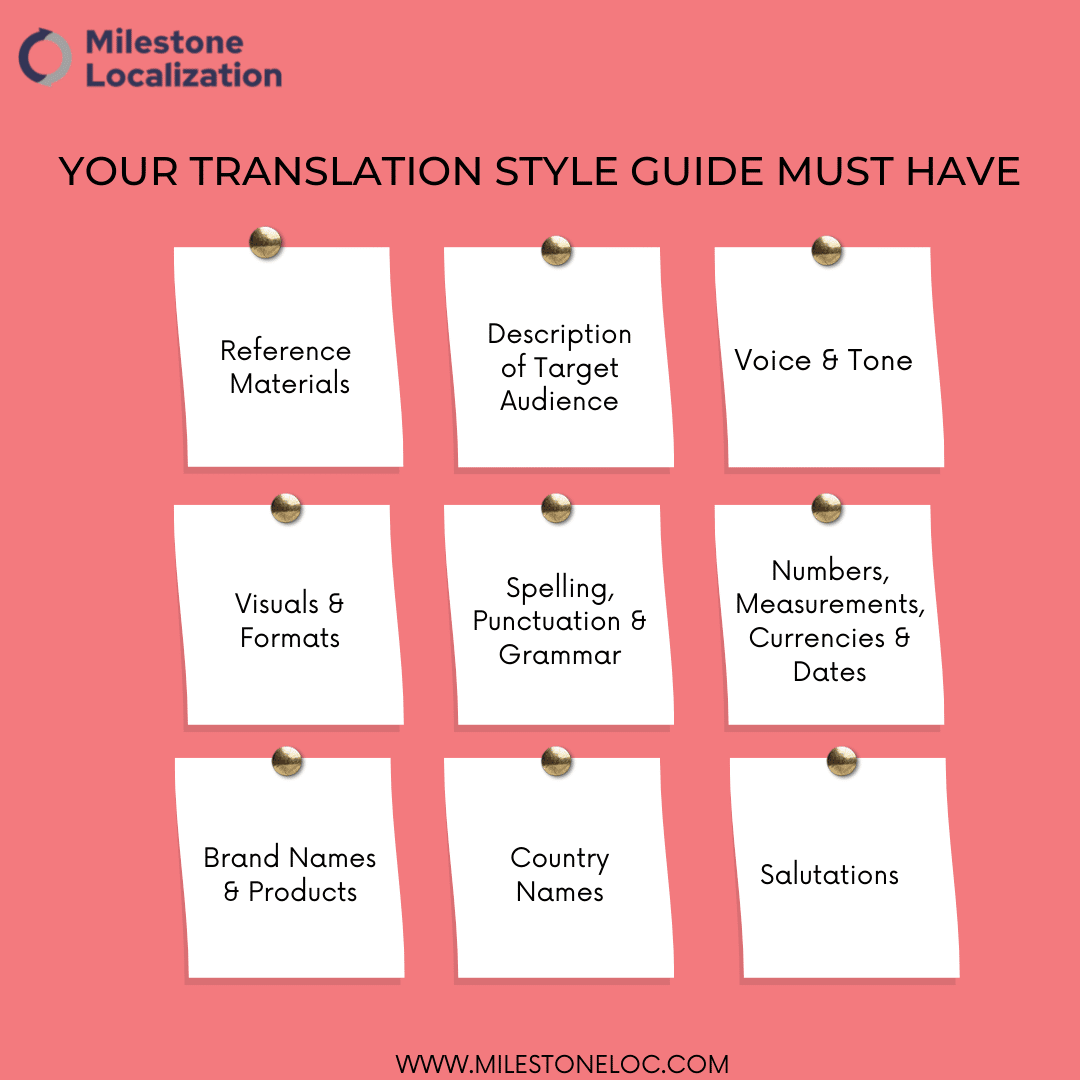
- Reference Materials
Make sure to provide your LSP with different resources such as background information of the materials that you want to be localized, explanations on how closely the LSP should follow the source text, and the purpose of the materials (e.g., informative or entertaining), etc. It’s always beneficial to include samples of previous translations, if available.
In your reference material, you can include content from your local competitors with a similar brand voice and target audience. This will help the translators understand the industry jargon in the local language.
- The Description of Target Audience
Most marketing teams usually develop a profile of that target audience(s) which would be beneficial for the localization team as well. Such customer base descriptions include certain personality traits and characteristics such as age, sex, country, region, shopping habits, any other routines, etc. This information will help the localization team get a clear idea of designing the content for the target audience of your company.
This is essential information as the tone and language will depend on the demographics of your target audience.
- Voice & Tone
Every company has a voice. So, adding a detailed description of your brand’s voice and tone will help linguists recreate your content as consistently and as convincingly as possible.
It’s best to include adjectives (some marketers also add personality types) to explain how the content should sound. For instance, conversational tone, sophisticated tone, academic or traditional language, neutral tone, etc.
- Visuals & Format
This aspect is not about design, but a general description of your brand’s colors and logos, preferable fonts, and general rules for embedding videos, links or images, or any other elements. Overall, you have to sum up your brand’s look so that the localization team can do their job well.
- Spelling, Punctuation & Grammar.
This aspect may seem unnecessary, but the devil is in the detail, as we all know. Make sure that you have cleared out all these little details before you dive into the localization process.
You can discuss these aspects with your LSP. Make sure to cover everything in terms of capitalization, slang, puns, jargon, idioms, culturally-specific references, slogans and headlines, first, second, or third person voice, and numerals, especially in currencies, tenses as well as trademarks and copyrighted terms.
You don’t have to pick a single spelling variety. For instance, if you want to target both the UK and the US, you should specify that you want your content localized in both variations.
- Numbers, Measurements, Currencies & Dates
As you may know, there are different currencies and measurements around the world.
For instance,
In Europe, weight is usually measured in kilograms, while in the US, in ounces or pounds. When you expand to new markets, you have to consider localizing aspects such as numbers, currencies, date format, and measurements.
All these details and preferences should be included in the translation style guide. For instance, if you want to expand to Canada, you might as well want to include measurements such as meters, feet, and inches since they are widely used in this locale.
You can discuss all possibilities with your LSP and then include all the details in your style guide to avoid confusion during the localization process.
Also Read: Top Global Brands With Exceptional Localization Strategies
- Brand Names & Products.
You don’t need to translate or localize every single detail of your brand. If you think that it would not harm your brand image, you can leave products’ names or your brand’s name as it is, without translating it.
Depending on the language and script, you can either translate, transliterate or leave the brand name as it is.
Frito-Lay’s world-famous chips are known by different names in different parts of the world.
India/USA/Canada and several others: Lay’s
UK/Ireland: Walkers
Australia: Smith’s
Egypt: Chipsy
Mexico: Sabritas
Brazil: Elma Chips
- Country Names
Similar to the point above, it is up to you if you want to translate countries’ names or not translate them. Nevertheless, you have to add all this information to your company’s style guide.
For example, the United States of America has different names in every language:
Spanish: Estados Unidos
German: Vereinigte Staaten
French: États-Unis
Dutch: Verenigde State
- Salutations
Depending on your brand’s tone and voice, you have to consider how to translate salutations.
For example, if your brand is oriented toward a younger customer base, you might opt for a more friendly salutation. If your target audience consists of adults in a formal setting, you might address them as “Mr./Ms.”
What’s more, you have to consider what possible equivalents are out there for тхесе salutations. For instance, in German, it would be “Herr/Frau,” while in Bulgarian “Г-н/Г-жа.”
Regardless of your decision, it should be included in the style guide, so that linguists know what is expected from them.
- Names and Examples
If you are translating creative or educational content, you might want to localize names and examples in your content.
For example, if you are localizing your content for India, you might want to change your character names to names that are popular in India such as Raj, Aishwarya, Rahul, and Sharma.
You might also want to change the names of places, food, celebrity, and pop culture references.
This is a common practice in the localization of games, learning content, and fiction.
Also Read: Top Qualities of a Good Translation
Free Translation Style Guide Template
own style guide for an effective localization process.
Best Practices For Creating & Using A Translation Style Guide:
- You have to compile all existing reference materials, which you consider helpful, and then send them to the LSP along with the content that you want to be localized.
- The LSP then analyzes the reference materials and determines the areas that need to be featured in the style guide based on the content that is to be localized.
- Then the LSP devises a “draft” of the style guide and sends their suggestions to the client, who reviews them.
Make sure that the style guide has plenty of examples for each point. This make it easy for the linguist to understand the instructions. - Once all elements are approved, the client sends back the resources to the LSP.
- The LSP devises a final version of the style guide and sends it to the client for review.
- After the style guide is approved by the client, the LSP inserts it into the localization tools that are required for the project and sends them to translators and editors.
Remember! Different style guides are made for different languages. Sometimes, you can club a group of languages from the same family and region together (such as Indian languages and Nordic languages).
However, the best practice is to make a separate style guide for each language you are translating into.
Also Read: What is a Localization Software?
In conclusion
All in all, a translation style guide evolves as your brand does. Indeed, such a resource is worth investing in only when you are willing to constantly update it. You have to make sure that the guide reflects your company’s development.
If you are looking to prepare a Translation style guide for your business or make changes to your existing style guide, We’re here to help. Milestone Localization is the leading Translation and Localization Agency In India & UK. Get in touch.

